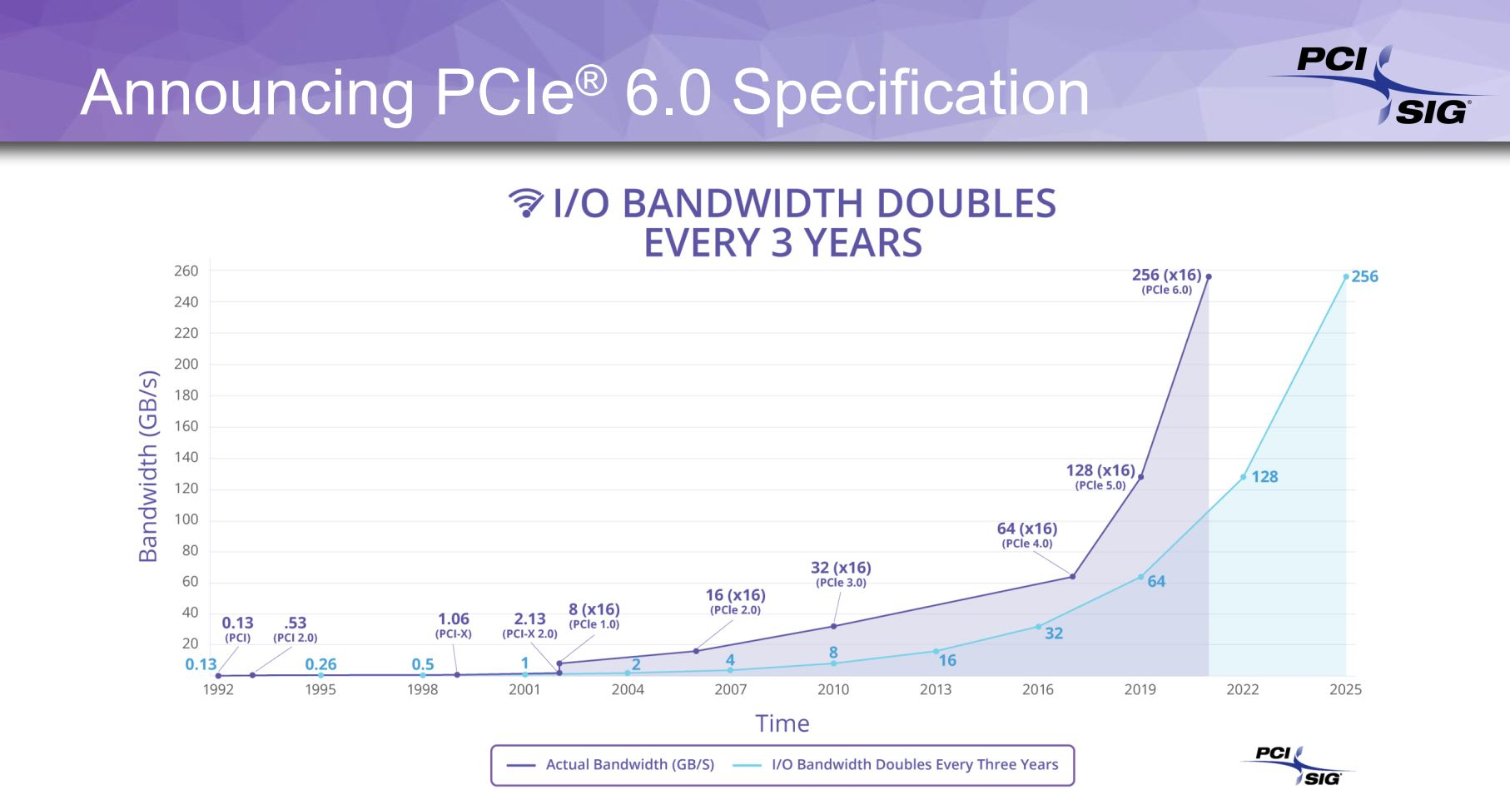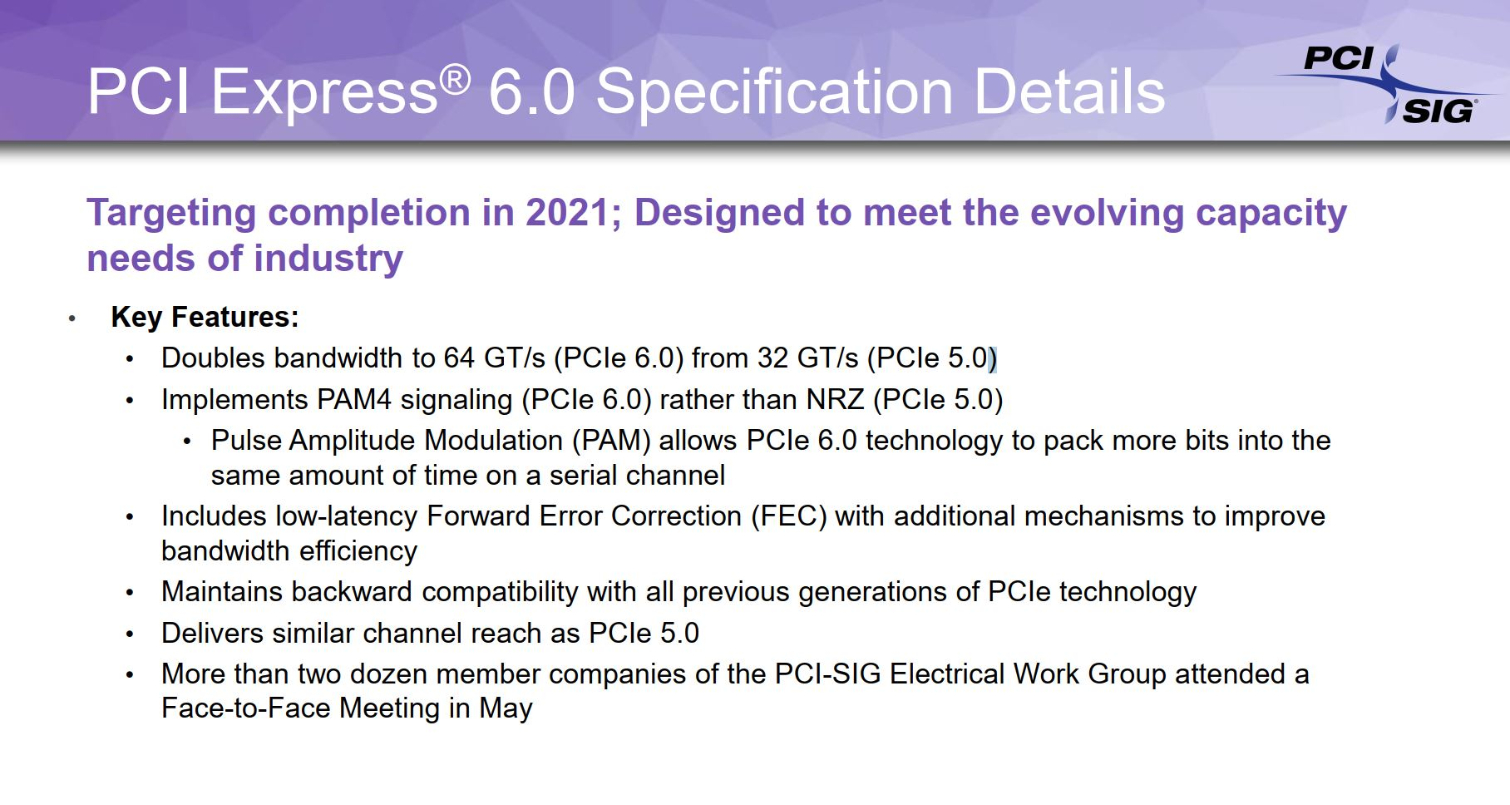PCI-SIG Announces PCIe 6.0, up to 256 GBps in 2021
The PCIe 4.0 interface is finally coming to market next month with the launch of AMD's Ryzen 3000 series processors, but the PCI-SIG, the standards body behind the PCIe specification, is already plowing forward with work on PCIe 6.0, which it announced will be completed in 2021. The announcement comes on the heels of the body's formal release of the PCIe 5.0 standard last month.

The new PCIe 6.0 interface double the Gigatransfer rate to 64 GT/s, which doubles effective bandwidth over PCIe 5.0 to 256 GB/s of throughput and retains the same maximum of 16 lanes.
| Row 0 - Cell 0 | Bandwidth | Gigatransfer | Frequency | Encoding |
| PCIe 1.0 | 8 GB/s | 2.5 GT/s | 2.5 GHz | 8b/10b |
| PCIe 2.0 | 16 GB/s | 5 GT/s | 5.0 GHz | 8b/10b |
| PCIe 3.0 | 32 GB/s | 8 GT/s | 8.0 GHz | 128b/130b |
| PCIe 4.0 | 64 GB/s | 16 GT/s | 16.0 GHz | 128b/130b |
| PCIe 5.0 | 128 GB/s | 32 GT/s | 32.0 GHz | 128b/130b |
| PCIe 6.0 | 256 GB/s | 64 GT/s | 32.0 GHz | PAM4 |

The new PCIe 6.0 interface switches to PAM4 encoding from the NRZ 128b/130b encoding scheme used for PCIe 3.0, 4.0, and 5.0. The PAM4 encoding scheme is widely used in networking, so it is a known quantity that should be relatively easy to deploy. PAM4 uses forward error correction (FEC) to help boost transfer rates, and PCI-SIG also points to other unspecified mechanisms that will improve bandwidth efficiency.
As we've seen with all versions of the PCIe specification, PCIe 6.0 is backward compatible with the existing PCIe interfaces.

Channel reach, i.e., the "distance" the signal can travel, remains similar for PCIe 6.0 as it is with the PCIe 5.0 interface, which is critical to ensure broad industry uptake. The PCI-SIG doesn't provide a specific distance measurement for channel reach, instead it specifies the amount of tolerable signal loss, which remains at 36dB for PCIe 6.0.
The faster release of the PCIe 5.0 interface means PCI-SIG met its two-year goal of developing a newer revision of the spec, which is a welcome change after the seven-year wait for PCIe 4.0. The committee hopes to meet the same two-year cadence for the PCIe 6.0 interface and publish the specification in full in 2021, and if history holds true, we'll see devices arrive in 2022.
There are precious few PCIe 4.0 devices coming to market in the near term, like AMD's Navi graphics cards and a wave of SSDs based on Phison's new controller (exclusive PCIe 4.0 SSD testing here), but we aren't aware of any new PCIe 5.0 devices landing soon. Given the faster cadence of releases of the PCIe standard, it is possible that PCIe 4.0 will be a short-lived spec. That shouldn't impact those of us that want to move forward to PCIe 4.0 devices, though, as backwards compatibility means those devices will be useful for years to come.
Get Tom's Hardware's best news and in-depth reviews, straight to your inbox.

Paul Alcorn is the Editor-in-Chief for Tom's Hardware US. He also writes news and reviews on CPUs, storage, and enterprise hardware.
-
hannibal Thing are getting old fast ;)Reply
Just good thing. This mean no need To increase pci lines in normal user computers. Just More speed with those few... -
thegriff Man and I still have a backup computer that has an AGP interface. Gotta, put that thing to rest and move over rest of fils :(Reply -
vern72 "It is possible that PCIe 4.0 will be an outdated spec"? It already is by 5.0! I hope 5.0 catches on quickly but 6.0 can wait. I guess it depends how easy it would be to implement the PAM4 encoding scheme in PCI.Reply -
JamesSneed Replyvern72 said:"It is possible that PCIe 4.0 will be an outdated spec"? It already is by 5.0! I hope 5.0 catches on quickly but 6.0 can wait. I guess it depends how easy it would be to implement the PAM4 encoding scheme in PCI.
PCIE 4.0 is already more expensive to implement. You really need a chipset made on a 10nm/7nm process to be efficient enough to not need active cooling. Then you have increased signaling so you need short clean traces which can increase motherboard layers all making it more costly.
PCIE 5.0 is going into servers. Intel and AMD are not bringing PCIE 5.0 into desktops in the near future as its complete overkill and is very costly right now. PCIE 6.0 is also going to live in server for many years as well.